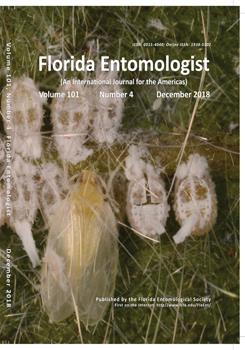Ephestia kuehniella Zeller (Lepidoptera: Pyralidae) and Sitotroga cerealella Olivier (Lepidoptera: Gelechiidae) are considered important pests of stored products in Brazil. The purpose of this study was to determine if E. kuehniella and S. cerealella feed on Brazil nuts, and to identify the type of damage caused by these insects. The damage caused by these insects starts as a scratched surface that evolves into deep tunnels until a complete change in the shape of the nut occurs. Due to their ability to injure intact nuts, and their capacity to produce severe damage and economic losses, E. kuehniella and S. cerealella have the potential to be among the primary pests of stored Brazil nuts.
In 2017, Brazil produced 37,664 tons of Brazil nuts (Bertholletia excelsa Bonpl.) (Lecythidaceae) (Instituto Brasileiro de Geografia e Estatística 2017). Production of these nuts is economically and socially significant, resulting in income and employment for thousands of families, and simultaneously ensuring conservation of the species and the forest environment (Santos 2012).
The requirement of national and international markets for highquality Brazil nuts for consumers has led to high collection and storage standards. Storage units are being built to promote adequate storage until processing. Among the problems involved in the storage of agricultural products are stored grain pests that are responsible for significant losses in rice, corn, soybeans, sorghum etc. (Martins et al. 1985; Santos et al. 2002; Caneppele et al. 2003; Silva et al. 2003; Alves et al. 2008; Faroni & Silva 2008; Elias et al. 2009; Alencar et al. 2011). Significant potential for damage to stored Brazil nuts also has been reported (Pires et al. 2017; Pires & Nogueira 2018).
In Brazil, there are a few species reportedly attacking B. excelsa under storage conditions. Among these are coffee berry borer, Hypothenemus hampei Wood & Bright (Coleoptera: Curculionidae: Scolytinae) (Gumier-Costa 2009), and Indianmeal moth, Plodia interpunctella Hübner (Lepidoptera: Pyralidae) (Gomes et al. 2015).
The occurrence of moths such as Ephestia kuehniella Zeller (Lepidoptera: Pyralidae) and Sitotroga cerealella Olivier (Lepidoptera: Gelechiidae) in grain storage units causes significant losses to grains (Quirino 2008). Ephestia kuehniella, also known as Mediterranean flour moth, is classified as a secondary pest of stored grains. Sitotroga cerealella, also known as Angoumois grain moth, is a primary pest of stored grains (Pacheco & Paula 1995; Puzzi 2000). The objective of this research was to determine if E. kuehniella and S. cerealella feed on Brazil nuts, and to describe the type of damage to Brazil nuts caused by these Lepidoptera.
Ten adults of E. kuehniella or S. cerealella were kept in plastic containers (13 cm diam × 16 cm ht) with Brazil nuts to obtain the eggs. After the appearance of the eggs on the surface of the nuts, each nut with an egg mass was separated and kept in a different 200 mL plastic container to facilitate the monitoring of this stage.
After egg hatch, groups of 10 E. kuehniella or 10 S. cerealella larvae were transferred to a 50 mL plastic container and provided with intact Brazil nuts, which were evaluated daily to observe the occurrence of surface lesions. Feeding by E. kuehniella and S. cerealella larvae was observed using a stereomicroscope (Model SZ0745TH, Diagtech Comércio e Importação Ltda., São Paulo, Brazil) situated in the Laboratory of Pests and Vectors of Amazon/Cerrado of the Universidade Federal de Mato Grosso - Campus de Sinop to help characterize the damage caused by these insects. Evaluation was terminated after the completion of the larval stage.
Ephestia kuehniella and S. cerealella larvae fed on intact Brazil nuts demonstrated that they are primary pests and capable of causing losses to this product under storage conditions. After 24 h exposure with intact Brazil nuts, E. kuehniella and S. cerealella larvae were found to produce superficial scratching in several areas (Figs. 1A, 2A–B). After 7 d, larger lesions were observed that altered the shape of the nuts (Figs. 1B, 2C). After longer periods of time, significant damage that completely changed the shape of the nuts was observed (Figs. 1C, 2D). Also, after 7 d, the nuts were covered with webbing woven by the larvae that prevented their release when tipping the jar (Figs. 1D–E, 2E–F).
Both E. kuehniella and S. cerealella larvae may be considered as primary pests of Brazil nuts due to their habit of digging galleries on the surface of the nut. They are responsible for causing lesions that initially appear in the form of superficial scrapes and subsequently in the form of tunnels that eventually modify the shape of the nut. Thus, these insects are potentially serious pests of this product, capable of producing both qualitative and quantitative damage. This type of damage is consistent with injury observed in other stored products (Santos et al. 1990). This damage also may lead to loss of germination potential (Santos et al. 1990). In addition, the webbing may be considered a contaminant that may hamper the handling and processing of this product by industry. It also may lead to problems similar to those reported in mills caused by webbing damaging machine components (Lorini et al. 2010).
We conclude that E. kuehniella and S. cerealella should be included in the list of pests that have the potential to generate considerable losses in stored Brazil nut, and may be classified as primary pests. Feeding by larvae leads to loss of quality and market value.
We acknowledge the students of Agronomy and Agricultural and Environmental Engineering, and also the agronomists for their technical support.







